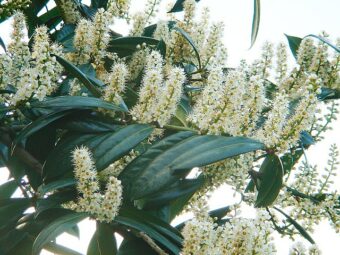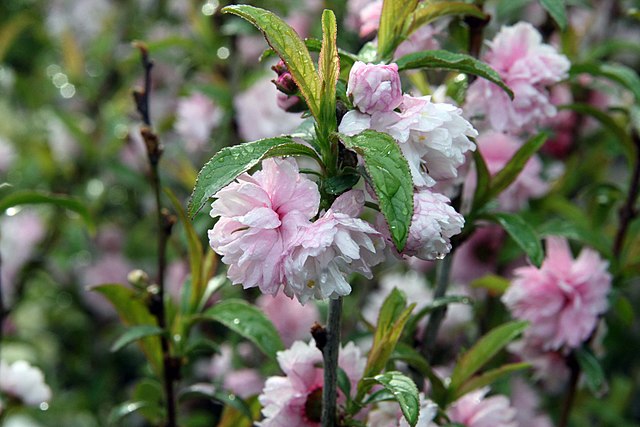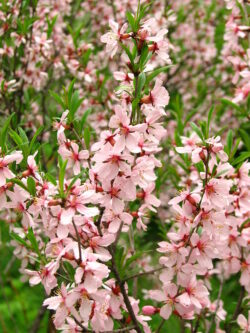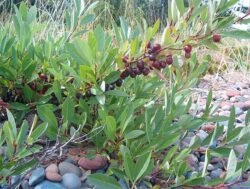In this article, we will discuss how to grow the smaller species of Prunus in Containers. All of us are familiar with the flowering Prunus trees that are commonly called ‘Flowering Cherries’ and the fruit trees of Plums, Cherries, Nectarines, Peaches, Almonds and Apricots. These are often large and unyielding trees, often not suitable to be grown in containers, but they are, however, various shrubby forms that can be grown in containers. They are mainly grown as shrubs that are used in borders and hedges, and those species include Prunus laurocerasus, the common Laurel, and Prunus lusitanica, the Portugal Laurel, but there are smaller plants that can be grown in containers.

Prunus is a genus of trees and shrubs, often producing edible fruits that are native to North America’s colder regions, areas of South America and the Paleotropics of Asia and Africa. 430 species belong to the Rosaceae (the Rose) family and are placed traditionally in the subfamily of Amygdaloideae.
THEY CAN BE DECIDUOUS OR EVERGREEN
Members of the genus can be either deciduous or evergreen, where the leaves are simple, alternate, usually lanceolate and unlobed. The flowers that appear in late winter to spring are usually white, pink or red, with five petals and five sepals, and numerous stamens. The flowers are either produced singly or on large racemes. The plants are followed by fleshy fruits technically drupes but known as prunes in this species. Each fruit has a large, single, hard-coated seed known as a ‘Stone’. In some species, the stone is edible, such as in almonds, but in others such as Apricots, they are toxic.
Prunus is divided into 6 subgenera and these are:
- Prunus subgenus Amygdalus which includes almonds and peaches.
- Prunus subgenus Prunus includes plums and apricots,
- Prunus subgenus Cerasus includes true, edible cherries.
- Prunus subgenus lithocerasus includes bush cherries.
- Prunus subgenus padus includes the bird cherries.
- Prunus subgenus laurocerasus, the cherry laurels.
Find out how to grow the shrubby Prunus in containers.
GROWING PRUNUS IN CONTAINERS
First, choose a container that is well-balanced with the Prunus in question and is large enough to hold the plant in. the container must have plenty of drainage holes to allow any excess water to drain away, Fill this container with a 2cm layer of gravel to improve drainage even further. On top of this, add up to 5cm below the top rim with good quality, multipurpose compost to which a handful of slow-release, general-purpose fertilizer has been mixed in.
Dig a hole at the centre of the container in the compost slightly bigger than the root ball it came in the original pot you bought it in. Place the plant in so that the top of the root ball is at the same level as the top surface of the compost in the container. Backfill with the growing media ensuring that no gaps remain, using more compost if you found it necessary. Firm the plant in and water well until it emerges from the drainage holes.
THE BEST GROWING AND CARE CONDITIONS
Place your plant and container in partial shade for evergreens or full sun for Prunus that are deciduous. Water well until the plant is well-established and this could mean watering frequently in hot and dry weather. After that, when 5cm below the top surface of the compost feels dry to the touch, then it is time to water. When watering make sure you do so until it just emerges from the drainage holes.

Prunus like the compost to be fertile, so every spring give a feed with a low-release, general-purpose fertilizer at the manufacturer’s recommended dosage.
Pruning is simple but must be done in late summer to avoid problems with bacterial canker and silver leaf diseases. All you need to do is cut out all dead branches, crossing branches and unwanted shoots
Propagation can be problematic for deciduous shrubs and it is easier to buy container-grown specimens from garden centres or online. For evergreen shrubs plant semi-ripe cuttings taken in summer and grown in a cold frame.
PESTS AND DISEASES

Prunus are not pests and disease-free as several diseases can attack them. This includes the cherry blackfly, where aphids suck sap from the foliage of fruiting and ornamental cherry. This causes the leaves to slightly curl in spring and early summer. To deal with this you can tolerate small infestations, or squash them between your fingers and thumb. You can also encourage natural predators to attack and consume these pests.
Cherry leaf scorch and leaf spot are common diseases with Prunus species. These are caused by fungi that turn the leaves shrivelled brown and remain hanging on the tree throughout winter. In leaf scorch the leaves become yellow, mottled and drop permanently, No chemical control exists but you can remove fallen leaves around the plant and remove any shrivelled leaves as soon observed.
‘Silver leaf’ is a fungal disease caused by open wounds if you prune very late. The best way to prevent this is to avoid pruning late at all costs, by allowing the wounds to heal before autumn and winter approach. If it develops the best course is to remove fruiting bodies as soon as they appear. Cut the branch beyond the area where the browning of the internal issue stops.
Bacterial canker is caused by two closely related bacteria that affect the stems and causes holes in early summer. It is noted as often slimy ooze appears. To avoid this prune before autumn arrives to stop the infection from setting in.
VARIETIES TO GROW

In the evergreen group, you have the compact and popular Prunus laurocerasus ‘Otto Lukyen’, which grows up to 1m high. In April, small white flowers appear on erect candles, which are followed by red-cherry-like fruits which turn black with age. Another variety is ‘Zabeliana’ which grows up to 1m high.
In the deciduous group, you have Prunus cistena (Crimsom Dwarf) which has red leaves and white/pink flowers in spring.
Prunus tenella ‘Fire Hill’ grows up to 1.33m tall and produces rosy-red flowers in April.
Prunus glandulosa ‘Alba Plena’ produces double-white flowers in May and grows up to 1.5m tall. An alternative is ‘Sinensis’ and ‘Rosea Pleana’ which produce double pink flowers in May.
Prunus trilobia produces pink, double flowers in April.
For ground cover, you can grow the 20cm high Prunus pumila ‘Depressa’ that has white flowers in May.
Prunus prostata grow up to 1m tall and has pink flowers in April.
CONCLUSIONS
In this article, we have discussed how to grow the shrubby Prunus in containers. They tend to be easy to grow and care for, and you have plenty of choice as to what to grow. They are not diseases or pests free but the effort makes it worthwhile, so why not grow one today?
If you have any questions or comments that you wish to make on growing shrubby Prunus in containers, please do so in the comment box below.
Happy Prunus growing.
